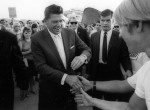Before he ever tried to tear down a wall, former president Ronald Reagan had a much more local foe: the University of California.
Forty-eight years ago this past Saturday, the conservative California governor delivered a stirring sermon: The state budget was tight, education was expensive, and people shouldn’t be given “intellectual luxuries” on the state dime. For Reagan, the role of state education was centered on producing good workers who could get jobs. The rest, he argued, was excessive.
In the nearly half century since this idea of a practical education was popularized, it’s become an idea so powerful that it has – to put it in words Reagan would appreciate – trickled down, from the mouths of old men to the ears and brains of young, doe-eyed college students.
In fact, the practicality-first argument put forth by Reagan has never been so powerful. Just two years ago, UCLA conducted a study of incoming freshman that concluded that about 81 percent of students came to college for one primary reason: to get a job. In 1971, only about forty percent of students said that was their primary reason for pursuing an education. Meanwhile, in that same time span, the number of students who said they wished to go to school to develop a meaningful philosophy of life plummeted, from 60 to 40 percent.
It’s true that in the costly environment of higher education today, no one can really afford to sit around and expand their mind for $30,000 a year. There needs to be some kind of return on investment. However, we can’t lose sight of the fact that there are real benefits to getting an education without a practical end-goal in mind. Striking a balance between liberal and practical approaches to higher education is key to achieving the best experience and fullest benefits from school.
That balanced approach was commonplace when Pat Brown, our current governor’s father, signed the California Master Plan for Higher Education into existence in 1960, essentially creating the three-tiered system that the University of California, California State University and California Community Colleges operate in today.
The Master Plan dictated that everyone in the state should have a spot somewhere along this higher education spectrum. There was no tuition, only low fees. Essentially, as long as someone was willing to work, a higher education was in reach. The legislation was an exercise in liberal educational theory if there ever was one.
And it worked. Enrollment shot up, and thousands flocked to get a degree.
However, in the 1980’s, a deep recession and burgeoning technology sector led to, for the first time, a growing gap between how much money certain degree holders made. After that, employers began looking more closely at what they considered valuable degrees – and ever since, this income gap between degree-holders has existed.
And the importance of practicality in higher education continues to grow stronger. Scott Walker, the Governor of Wisconsin and 2016 presidential hopeful, attempted to change the value statement of his state’s university system to emphasize “(meeting) the state’s workforce needs.”
Even Jerry Brown, whose own father created that higher education system so fundamentally based on the intellectual largesse Reagan mentioned, has viewed education in the same light. He has consistently suggested plans to turn the UC into a lean, mean degree machine. He has proposed financial incentives for schools that can push out graduates sooner – into the workforce and off the state dime.
What this means, essentially, is that our attitudes about higher education aren’t so much a product of our own intrinsic values, but of what broader societal forces have defined for us. And that over the course of the last 30 years, that definition has swung further and further to the “practical” side of the spectrum. It also indicates that the way we talk about education can change – and with that change can come real, legislative progress.
If we can shift our mindset out of this strange “practicality versus liberal arts” dichotomy we have bought too far into, we can ultimately produce those with the best credentials for the job and the means to get one.
And some people are already doing that. Dr. Loretta Jackson-Hayes, in a Washington Post op-ed, described the necessity of scientists that can think like liberal arts majors. She argues that the key to being a good scientist is creativity – something fostered in the liberal arts. At Santa Clara University, in order to graduate, students are required to write a thesis that involves multidisciplinary research and uses scientific principles to examine more abstract concepts.
It’s at the intersection of practicality and creativity that we find our most treasured asset: innovation. It’s this kind of innovation that produces truly interesting and dynamic intellectual work.
Without a road that allows us to explore both the practical and ideological benefits of education, however, we’ll end up at both a societal and economic dead end.
